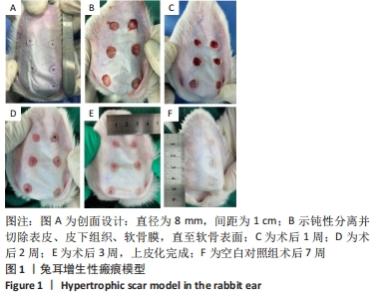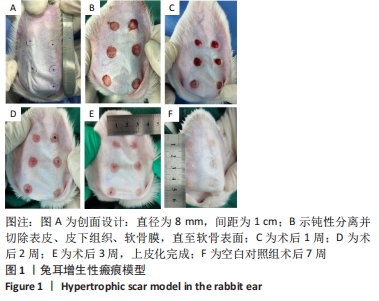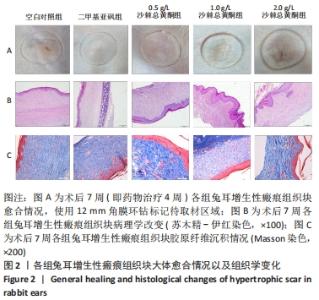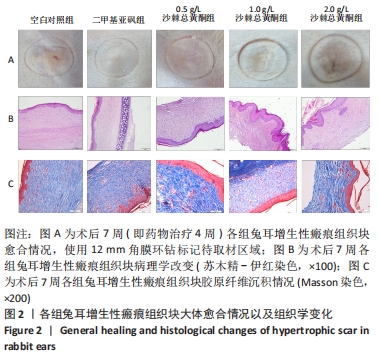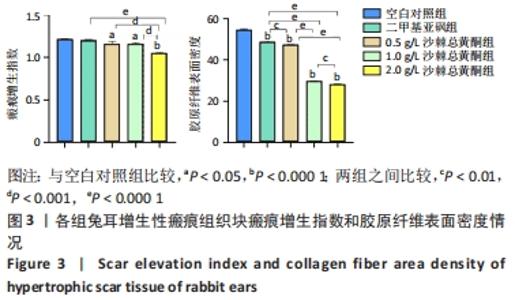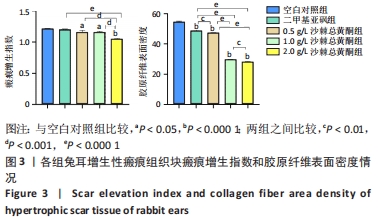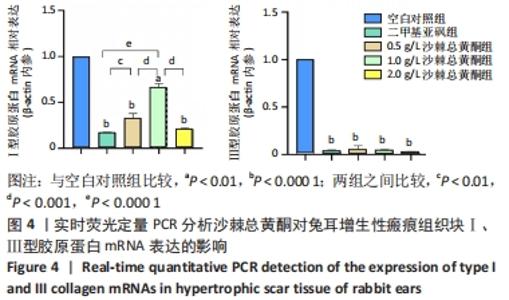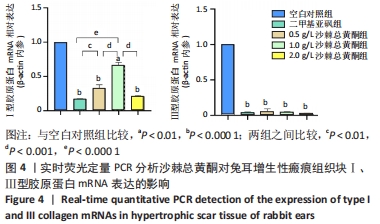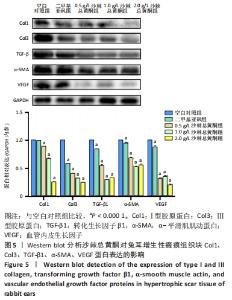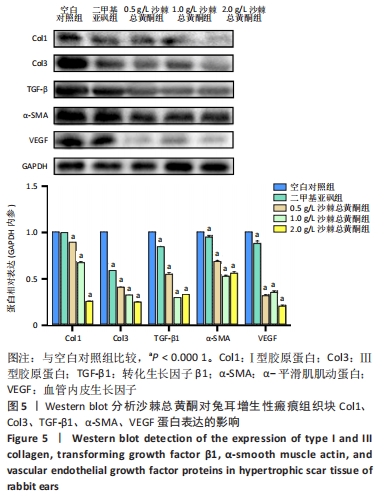[1] LEE HJ, JANG YJ. Recent Understandings of Biology, Prophylaxis and Treatment Strategies for Hypertrophic Scars and Keloids. Int J Mol Sci. 2018;19(3):711.
[2] WANG ZC, ZHAO WY, CAO Y, et al. The Roles of Inflammation in Keloid and Hypertrophic Scars. Front Immunol. 2020;11:603187.
[3] ZHANG T, WANG XF, WANG ZC, et al. Current potential therapeutic strategies targeting the TGF-β/Smad signaling pathway to attenuate keloid and hypertrophic scar formation. Biomed Pharmacother. 2020; 129:110287.
[4] 张东,邬国栋. 沙棘黄酮的化学成分及药理作用研究进展[J]. 中国药房,2019,30(9):1292-1296.
[5] 周浩楠,胡娜,董琦,等. 沙棘化学成分及药理作用的研究进展[J]. 华西药学杂志,2020,35(2):211-217.
[6] 李艺文,唐志书,张珍,等. 沙棘总黄酮抗单侧输尿管梗阻大鼠肾脏纤维化作用及机制[J]. 中南药学,2021,19(5):845-850.
[7] 白跳,迟丽屹,高宇勤,等. 异鼠李素对糖尿病大鼠心肌纤维化的干预作用[J]. 新疆医科大学学报,2018,41(7):865-869.
[8] 王晖,李小静. 兔耳瘢痕模型的研究与应用进展[J]. 中华整形外科杂志,2015,31(2):158-160.
[9] 中国整形美容协会瘢痕医学分会. 瘢痕早期治疗全国专家共识(2020版)[J]. 中华烧伤杂志,2021,37(2):113-125.
[10] 韦凌霞,丁茂鹏,王志旺,等. 基于数据挖掘及网络药理学方法探讨含当归中药复方抗肝纤维化的用药规律及作用机制[J]. 中药新药与临床药理,2020,31(11):1323-1331.
[11] 盖李乐,袁丁,张长城,等. 淫羊藿总黄酮通过TGF-β1/Smad3信号通路改善自然衰老大鼠肾脏组织纤维化[J]. 天然产物研究与开发, 2021,33(3):373-379.
[12] 曹后康,高雅,黄思茂,等. 杠板归总黄酮抗大鼠肝纤维化作用的机制研究[J]. 中国药理学通报,2017,33(9):1303-1308.
[13] 焦美,钟涵宇,陈克研,等. 槲皮素通过TGF β1/Smad3信号通路改善慢性心衰大鼠心肌纤维化[J]. 解剖科学进展,2020,26(4):391-395.
[14] 高海娜,林莺,张静,等. 异鼠李素对长波紫外线照射人皮肤成纤维细胞ER/TGF-β1/Smad3信号通路的影响[J]. 国际中医中药杂志, 2020,42(10):973-977.
[15] SARI E, BAKAR B, DINCEL GC, et al. Effects of DMSO on a rabbit ear hypertrophic scar model: A controlled randomized experimental study. J Plast Reconstr Aesthet Surg. 2017;70: 509-517.
[16] YUAN FL, SUN ZL, FENG Y, et al. Epithelial-mesenchymal transition in the formation of hypertrophic scars and keloids. J Cell Physiol. 2019; 234(12):21662-21669.
[17] BERMAN B, MADERAL A, RAPHAEL B. Keloids and Hypertrophic Scars: Pathophysiology, Classification, and Treatment. Dermatol Surg. 2017; 43 Suppl 1:S3-S18.
[18] CHO JW, CHO SY, LEE SR, et al. Onion extract and quercetin induce matrix metalloproteinase-1 in vitro and in vivo. Int J Mol Med. 2010; 25(3):347-352.
[19] YANG JH, KIM SC, KIM KM, et al. Isorhamnetin attenuates liver fibrosis by inhibiting TGF-β/Smad signaling and relieving oxidative stress. Eur J Pharmacol. 2016;783: 92-102.
[20] LIMANDJAJA GC, BELIEN JM, SCHEPER RJ, et al. Hypertrophic and keloid scars fail to progress from the CD34- /α-smooth muscle actin (α-SMA)+ immature scar phenotype and show gradient differences in α-SMA and p16 expression. Br J Dermatol. 2020;182(4):974-986.
[21] WILGUS TA. Vascular Endothelial Growth Factor and Cutaneous Scarring. Adv Wound Care (New Rochelle). 2019;8(12):671-678.
[22] SHI J, WU Y, GUO S, et al. The efficacy of anti-VEGF antibody-modified liposomes loaded with paeonol in the prevention and treatment of hypertrophic scars. Drug Dev Ind Pharm. 2019;45(3):439-455.
|
